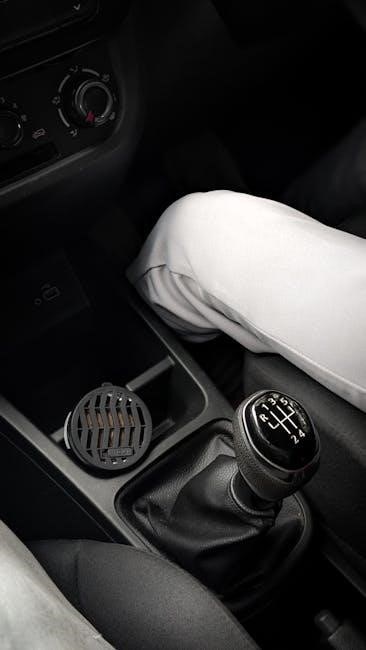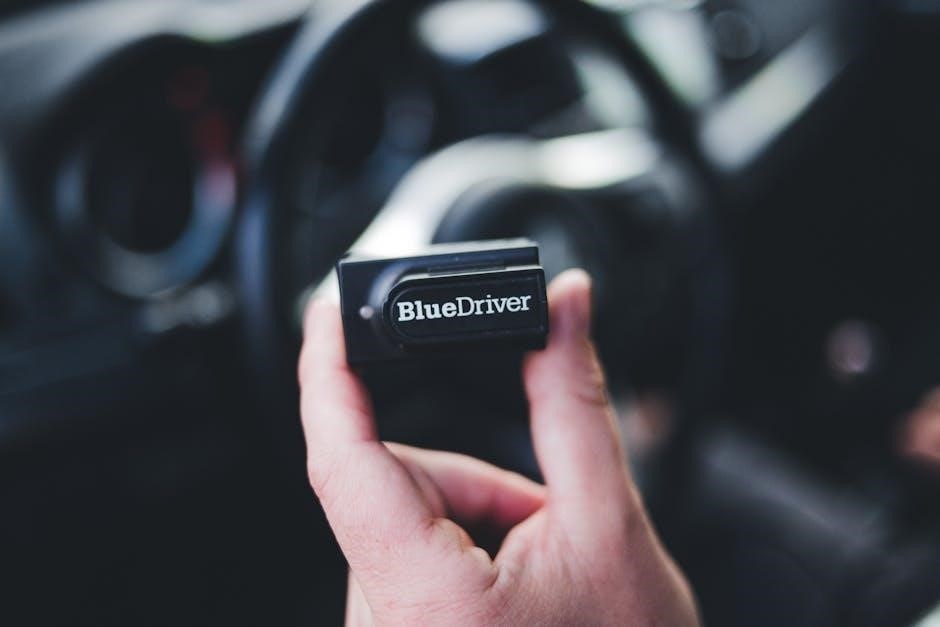The New Jersey Driver Manual is an essential guide for understanding road rules, safe driving practices, and licensing requirements․ It helps new drivers prepare for their tests and ensures safe and confident driving in New Jersey․
What is the NJ Driver Manual?
The New Jersey Driver Manual is an official guide published by the New Jersey Motor Vehicle Commission (MVC)․ It provides detailed information on road rules, traffic signs, safe driving practices, and licensing requirements․ Designed for new and experienced drivers, the manual covers essential topics such as traffic laws, right-of-way rules, speed limits, and driver responsibilities․ Available in PDF format, it serves as a comprehensive resource for preparing for driver’s license tests, including the knowledge and road tests․ The manual is regularly updated to reflect current driving regulations and safety standards in New Jersey․
Importance of the NJ Driver Manual
The NJ Driver Manual is a primary resource for learning New Jersey’s traffic laws, road signs, and safe driving practices․ It is essential for preparing for the knowledge test required to obtain a driver’s license․ By studying the manual, drivers gain a thorough understanding of road rules, reducing the risk of accidents․ It also serves as a reference for experienced drivers to refresh their knowledge․ The manual’s guidance ensures compliance with state-specific regulations, promoting safer roads and responsible driving habits․ Its availability in PDF format makes it easily accessible for everyone․
Recent Updates to the NJ Driver Manual
The NJ Driver Manual has been updated to reflect current laws and safety standards․ The latest revision includes new sections on distracted driving, updated DUI laws, and enhanced guidelines for road safety․ It also incorporates changes in traffic regulations and signs․ The manual now provides clearer instructions for first-time drivers and emphasizes the importance of the Graduated Driver License (GDL) program․ These updates ensure drivers are well-informed about New Jersey’s specific driving requirements, helping to promote safer roads and responsible driving practices․ The updated PDF version is available for easy access and study․
Where to Download the NJ Driver Manual PDF
The New Jersey Driver Manual PDF is available for free download on the official New Jersey Motor Vehicle Commission (NJ MVC) website․ Visit www․njmvc․gov and navigate to the “Driver Manual” section․ The manual is offered in both English and Spanish to accommodate all drivers․ Additionally, it can be accessed through various driver education platforms that provide direct links to the PDF․ Ensure you download the latest version, as it includes the most recent updates to traffic laws and regulations․ This resource is essential for preparing for the knowledge test and understanding New Jersey’s driving requirements․

Eligibility Requirements for a New Jersey Driver’s License
To obtain a New Jersey driver’s license, applicants must meet age, residency, and documentation requirements․ Vision and medical standards must also be satisfied, including a vision test․
Age Requirements for Obtaining a Driver’s License
In New Jersey, the minimum age to apply for a learner’s permit is 16 years old․ At 17 years old, drivers can obtain a probationary license, which restricts driving privileges․ A full, unrestricted driver’s license is issued at 18 years old․ Applicants under 18 must complete a state-approved driver education course and hold a permit for at least six months․ Vision tests are required for all applicants to ensure safe driving capabilities․
Residency and Documentation Requirements
To apply for a driver’s license in New Jersey, you must meet residency and documentation requirements․ Applicants must provide proof of identity, Social Security number, and New Jersey residency․ Acceptable documents include a valid U․S․ birth certificate, passport, or permanent resident card for identity, and utility bills or bank statements for residency․ Applicants under 18 must also provide parental consent․ All documents must be valid and up-to-date to complete the application process successfully․
Medical and Vision Requirements
Applicants for a New Jersey driver’s license must meet medical and vision standards․ A vision test is required to ensure you can safely operate a vehicle․ The test assesses visual acuity, with a requirement of 20/40 in each eye or combined vision․ If corrective lenses are needed, they must be worn while driving․ Certain medical conditions may require additional documentation or evaluation․ Applicants with serious health issues must provide a medical certification form completed by a licensed physician․ These requirements ensure public safety and help maintain responsible driving practices in New Jersey․

The Licensing Process in New Jersey
The New Jersey licensing process involves completing a series of steps, including meeting eligibility requirements, submitting documents, passing vision and knowledge tests, and completing a road test․ The process is designed to ensure applicants are qualified and prepared to drive safely․ The Graduated Driver License (GDL) program is a key component for new drivers, promoting safe driving practices through structured phases․ This systematic approach helps applicants understand and fulfill all necessary requirements efficiently․
Step-by-Step Guide to Applying for a Driver’s License
Applying for a driver’s license in New Jersey involves a structured process․ First, check eligibility requirements, including age and residency․ Gather necessary documents, such as proof of identity and residency․ Visit an MVC agency and complete a vision test․ Pass the knowledge test, which covers traffic laws and safe driving practices․ Upon passing, obtain a learner’s permit and complete the required behind-the-wheel training․ Schedule and pass the road test to demonstrate driving skills․ Finally, pay the licensing fee and receive your driver’s license․ The process ensures applicants are fully prepared and meet all state requirements for safe driving․
Understanding the Graduated Driver License (GDL) Program
The Graduated Driver License (GDL) Program in New Jersey is designed to help new drivers gain experience gradually․ It consists of three stages: permit, probationary, and full licensure․ During the permit phase, drivers practice under supervision․ The probationary phase allows unsupervised driving with restrictions, such as limits on passengers and nighttime driving․ After meeting all requirements, drivers transition to a full license․ The GDL Program reduces the risk of accidents by introducing driving privileges in a controlled manner, ensuring new drivers develop essential skills and confidence behind the wheel․
Required Documents for Application
To apply for a driver’s license in New Jersey, you must provide specific documents․ These include proof of identity, such as a birth certificate or passport, and proof of residency, like a utility bill or lease․ Additionally, you’ll need to submit Social Security documentation and complete a vision test․ For applicants under 18, a parent or guardian’s signature is required․ Ensure all documents are valid and up-to-date, as incomplete applications may delay processing․ Check the official MVC website for the most current list of required documents to avoid any issues during your application process․

Road Rules and Regulations in New Jersey
Road Rules and Regulations in New Jersey, detailed in the driver manual, cover traffic laws, speed limits, right-of-way rules, and DUI laws․ Adhering to these ensures safe and lawful driving․
Overview of New Jersey Traffic Laws
The New Jersey Driver Manual provides a comprehensive overview of the state’s traffic laws, focusing on road safety and responsible driving practices․ It covers essential topics such as speed limits, right-of-way rules, and DUI laws․ The manual also emphasizes the importance of adhering to traffic signals, pedestrian rights, and seat belt requirements․ By understanding these laws, drivers can reduce the risk of accidents and ensure a safer environment for all road users․ The manual serves as a key resource for both new and experienced drivers to stay informed and compliant with New Jersey’s traffic regulations․
Speed Limits and Safe Driving Practices
The New Jersey Driver Manual emphasizes the importance of adhering to posted speed limits, which vary based on road type and location․ Urban areas typically have lower limits, while rural highways allow higher speeds․ School zones and construction areas require extra caution and reduced speeds․ Safe driving practices include maintaining a safe following distance, adjusting speed for weather conditions, and avoiding reckless behaviors like tailgating or weaving lanes․ By following these guidelines, drivers can minimize risks, reduce accidents, and ensure a safer environment for all road users․ Consistent compliance with speed limits is crucial for road safety in New Jersey․
Right-of-Way Rules and Intersection Safety
The New Jersey Driver Manual outlines critical right-of-way rules to ensure safe navigation of intersections․ Drivers must yield to pedestrians and cyclists at crosswalks and always obey traffic signals․ At four-way stops, vehicles proceed in the order they arrive․ When turning left, drivers must yield to oncoming traffic․ Blind intersections require caution, with drivers slowing down and being prepared to stop․ Understanding these rules is vital for avoiding accidents and promoting smooth traffic flow․ Adhering to right-of-way guidelines helps maintain safety and order on New Jersey roads․

Safe Driving Practices
Safe driving practices emphasized in the NJ Driver Manual include defensive driving techniques, maintaining safe distances, and adhering to speed limits․ Always avoid distractions and stay vigilant to ensure roadway safety․
Defensive Driving Techniques
Defensive driving involves anticipating potential hazards and reacting safely․ The NJ Driver Manual emphasizes maintaining a safe distance, scanning the road, and avoiding distractions․ It also teaches drivers to be aware of other road users’ actions, such as sudden stops or lane changes․ By staying alert and prepared, drivers can reduce the risk of accidents․ These techniques promote a proactive approach to driving, ensuring safety for all road users․ Regular practice of defensive driving skills helps build confidence and improves overall driving abilities․ Always prioritize caution and vigilance on New Jersey roads․
Distracted Driving and Its Consequences
Distracted driving significantly increases the risk of accidents and injuries on New Jersey roads․ The NJ Driver Manual highlights the dangers of texting, using handheld devices, and other distractions while driving․ Texting while driving is illegal in New Jersey, and violators face fines and penalties․ Distracted driving impairs reaction times, reduces awareness, and endangers passengers, pedestrians, and other drivers․ Staying focused on the road is crucial for safety․ The manual emphasizes the importance of avoiding distractions to prevent collisions and protect lives․ Always keep your eyes on the road and hands on the wheel․
Driving Under the Influence (DUI) Laws
Driving under the influence (DUI) of alcohol or drugs is a serious offense in New Jersey․ The legal blood alcohol content (BAC) limit is 0․08% for drivers over 21․ For commercial drivers, the BAC limit is 0․04%․ Penalties for DUI include fines, license suspension, and mandatory ignition interlock devices․ Repeat offenses result in harsher penalties, including jail time․ The NJ Driver Manual emphasizes the dangers of impaired driving and the importance of never driving after consuming alcohol or using substances that impair driving ability․ DUI convictions remain on your record and can impact insurance rates and employment opportunities․

Traffic Signs and Signals
Traffic signs and signals guide drivers, ensuring safe navigation․ They include regulatory signs like speed limits, warning signs for hazards, and guide signs for directions․ Understanding them is crucial for safe driving in New Jersey․
Types of Traffic Signs and Their Meanings
Traffic signs are categorized into regulatory, warning, and guide signs․ Regulatory signs, such as stop signs and speed limit signs, enforce traffic laws․ Warning signs, like curve ahead or pedestrian crossing signs, alert drivers to potential hazards․ Guide signs provide directional information and help navigate roads․ Each sign has a specific design and color to convey its message clearly․ Understanding these signs is essential for safe driving and adhering to New Jersey traffic laws․ The NJ Driver Manual details these signs to ensure drivers recognize and respond appropriately to them while on the road․
Understanding Traffic Signal Phases and Rules
Traffic signals are designed to ensure safe and efficient flow of traffic․ The standard phases include red, yellow, and green lights․ A red light signals drivers to stop, while green means go․ Yellow indicates the light is about to turn red, and drivers should prepare to stop if safe․ Special signals, like arrows, indicate specific lanes or turning directions․ Pedestrian signals and countdown timers are also used to manage crossings․ Drivers must obey signal rules to avoid accidents and violations․ The NJ Driver Manual explains these phases and rules in detail to promote safe driving practices․
Common Road Markings and Their Significance
Road markings are vital for guiding drivers and ensuring safe traffic flow․ Solid lines indicate boundaries between lanes or edges of the road, while dashed lines suggest areas where passing is allowed․ Arrows on the pavement direct traffic flow or indicate turning lanes․ Crosswalks and pedestrian markings alert drivers to pedestrian crossings․ Bike lane markings separate cyclists from vehicle traffic․ These markings are standardized to provide clear visual cues, helping drivers navigate safely and obey traffic laws․ Understanding these markings is crucial for safe driving, as explained in detail in the NJ Driver Manual․

Preparing for the Knowledge and Road Tests
Studying the NJ Driver Manual is key to success․ Understand traffic laws, road signs, and safe practices․ Practice with sample questions and ensure familiarity with vehicle safety checks․
What to Expect on the Written Knowledge Test
The written knowledge test evaluates understanding of New Jersey traffic laws, road signs, and safe driving practices․ Expect multiple-choice questions covering rules of the road, right-of-way scenarios, and driver responsibilities․ The test emphasizes recognition of traffic signs, including shapes, colors, and symbols, and their meanings․ Questions also address defensive driving techniques, distracted driving consequences, and DUI laws․ Study the NJ Driver Manual thoroughly, focusing on common violations and safe practices․ Practice with sample questions to build confidence and ensure readiness for the exam․ Understanding these concepts is crucial for passing and becoming a safe, informed driver․
Practice Questions and Study Tips
Practice questions are a valuable tool to assess readiness for the knowledge test․ Focus on multiple-choice and true/false questions covering road signs, traffic laws, and safe driving practices․ Study tips include setting aside dedicated time daily, using flashcards for road signs, and reviewing the NJ Driver Manual thoroughly․ Prioritize understanding concepts rather than memorizing answers․ Take timed practice tests to simulate exam conditions and identify areas for improvement․ Reviewing mistakes and seeking clarification ensures better retention․ Consistent practice and thorough study of the manual will build confidence and lead to success on the test․
Road Test Requirements and Evaluation Criteria
The road test evaluates your ability to safely operate a vehicle and follow traffic laws․ You must demonstrate control and coordination, adhere to speed limits, and use signals correctly․ Examiners assess your ability to navigate intersections, manage stopping distances, and maintain lane positioning․ Proper use of mirrors and checking blind spots are critical․ You’ll be tested on reversing, three-point turns, and merging into traffic․ Points are deducted for errors like failing to yield, improper signaling, or speeding․ The test requires a valid vehicle registration and insurance․ Practice and understanding the manual will help ensure a successful performance․

Commercial Driver’s License (CDL) in New Jersey
The New Jersey CDL program outlines requirements for commercial drivers, including eligibility criteria, license classifications, and mandatory training․ The manual guides applicants through the application and testing process․
Eligibility Requirements for a CDL
To apply for a Commercial Driver’s License in New Jersey, candidates must meet specific eligibility criteria․ Applicants must be at least 21 years old to drive interstate and 20 years old for intrastate operations․ They must be legal New Jersey residents and provide proof of identity and residency․ Additionally, applicants must pass a physical examination and meet federal medical certification standards․ A valid New Jersey passenger driver’s license is required before applying for a CDL․ Applicants must also pass a background check, especially for endorsements like Hazmat․ Proper documentation, including a completed CDL application, is necessary to begin the process․
CDL Classification and Endorsements
The New Jersey CDL is classified into three types: Class A, B, and C, each allowing operation of specific vehicle types․ Class A covers combination vehicles with a trailer, Class B for heavy straight trucks, and Class C for smaller vehicles like buses․ Endorsements are additional qualifications, such as Hazardous Materials (Hazmat), Tank Vehicles, Doubles/Triples Trailers, Passenger Transport, and School Buses․ Each endorsement requires specialized knowledge or skills and is essential for drivers seeking specific employment opportunities․ Understanding these classifications and endorsements is crucial for obtaining the correct CDL for your career goals․
Additional Testing and Training Requirements
In New Jersey, obtaining a CDL requires additional testing and training beyond the standard driver’s license․ Applicants must pass a written knowledge test covering general CDL requirements and specific endorsements․ A skills test, including a pre-trip inspection, basic vehicle control, and on-road driving, is also mandatory․ Training programs approved by the New Jersey Motor Vehicle Commission are recommended to prepare for these tests․ Certain endorsements, such as Hazmat or Passenger Transport, may require additional certifications or background checks․ These requirements ensure that CDL holders are fully prepared to operate commercial vehicles safely and efficiently on public roads․

Resources for Drivers
The official NJ MVC website offers the driver manual, driver education courses, and additional study materials to help drivers prepare for tests and safe driving․
Official NJ MVC Website and Contact Information
The official New Jersey Motor Vehicle Commission (NJ MVC) website is www․njmvc․gov․ Drivers can access the NJ Driver Manual, application forms, and licensing information․ For assistance, contact the MVC via email at mvc․BLSdrivingschoolsmvc․nj․gov or fax․ The website also offers resources for downloading the driver manual PDF, studying for tests, and understanding traffic laws․ It serves as a central hub for all driver-related inquiries, ensuring easy access to essential services and information․ The MVC website is a vital tool for both new and experienced drivers in New Jersey․
Driver Education Courses and Schools
Driver education courses in New Jersey are designed to teach new drivers essential skills and knowledge․ These courses are offered by state-approved driving schools and cover topics like road safety, traffic laws, and defensive driving techniques․ Many schools provide structured curriculums, practice tests, and hands-on training to prepare students for the written and road tests․ The MVC recommends enrolling in a driver education program to ensure a thorough understanding of the rules of the road․ Schools must submit annual supply orders to the MVC for driver education materials, ensuring up-to-date resources for students․ These programs are crucial for developing responsible and confident drivers․
Additional Study Materials and Guides
Beyond the NJ Driver Manual, additional study materials are available to help drivers prepare for their tests․ The official MVC website offers practice tests and guides that simulate the actual exam format․ Online platforms provide interactive tools, such as flashcards and video tutorials, to reinforce learning․ Mobile apps like “NJ Driver Test Prep” offer on-the-go practice․ Driver education courses also supply supplementary materials, including detailed study guides and real-world driving scenarios․ These resources ensure a comprehensive understanding of New Jersey’s driving laws and safe practices, helping applicants feel confident and prepared for their exams․

Frequently Asked Questions (FAQs)
Where can I find the NJ Driver Manual? How do I prepare for the knowledge test? What are the requirements for obtaining a driver’s license in New Jersey?
Common Questions About the NJ Driver Manual
Where can I download the NJ Driver Manual? The official PDF is available on the New Jersey Motor Vehicle Commission (NJ MVC) website․ What topics does it cover? The manual includes road rules, traffic signs, safe driving practices, and licensing requirements․ Is it free? Yes, the manual is provided at no cost to help drivers prepare for tests․ Can I access it in Spanish? Yes, a Spanish version is also available․ How often is it updated? The manual is regularly revised to reflect current laws and regulations․ Studying it is essential for passing the knowledge test and becoming a safe, informed driver in New Jersey․
Questions About the Licensing Process
What steps are involved in obtaining a driver’s license in New Jersey? The process typically includes obtaining an examination permit, completing driver education, and passing vision, knowledge, and road tests․ How long does the licensing process take? It varies based on age and compliance with requirements․ What documents are needed? Proof of identity, residency, and Social Security number are required․ Are there fees involved? Yes, fees for permits, tests, and license issuance apply․ The NJ Driver Manual provides detailed guidance on each step to ensure a smooth and efficient process for applicants․
Questions About Traffic Laws and Violations
What are the key traffic laws in New Jersey? The NJ Driver Manual outlines rules like speed limits, right-of-way procedures, and DUI regulations․ What happens if I violate traffic laws? Penalties may include fines, license points, or suspension․ How do I handle a traffic ticket? Instructions are provided in the manual․ Are there specific laws for distracted driving? Yes, New Jersey prohibits texting and handheld phone use while driving․ Understanding these laws helps drivers avoid violations and stay safe on the road․ The manual is a comprehensive resource for adhering to traffic regulations and maintaining a clean driving record․





